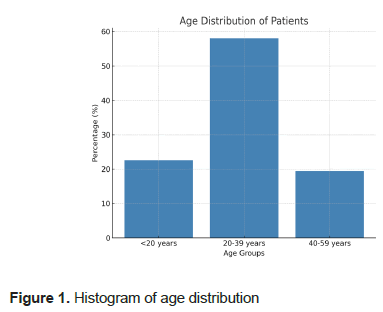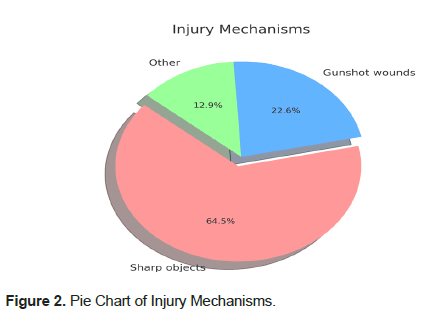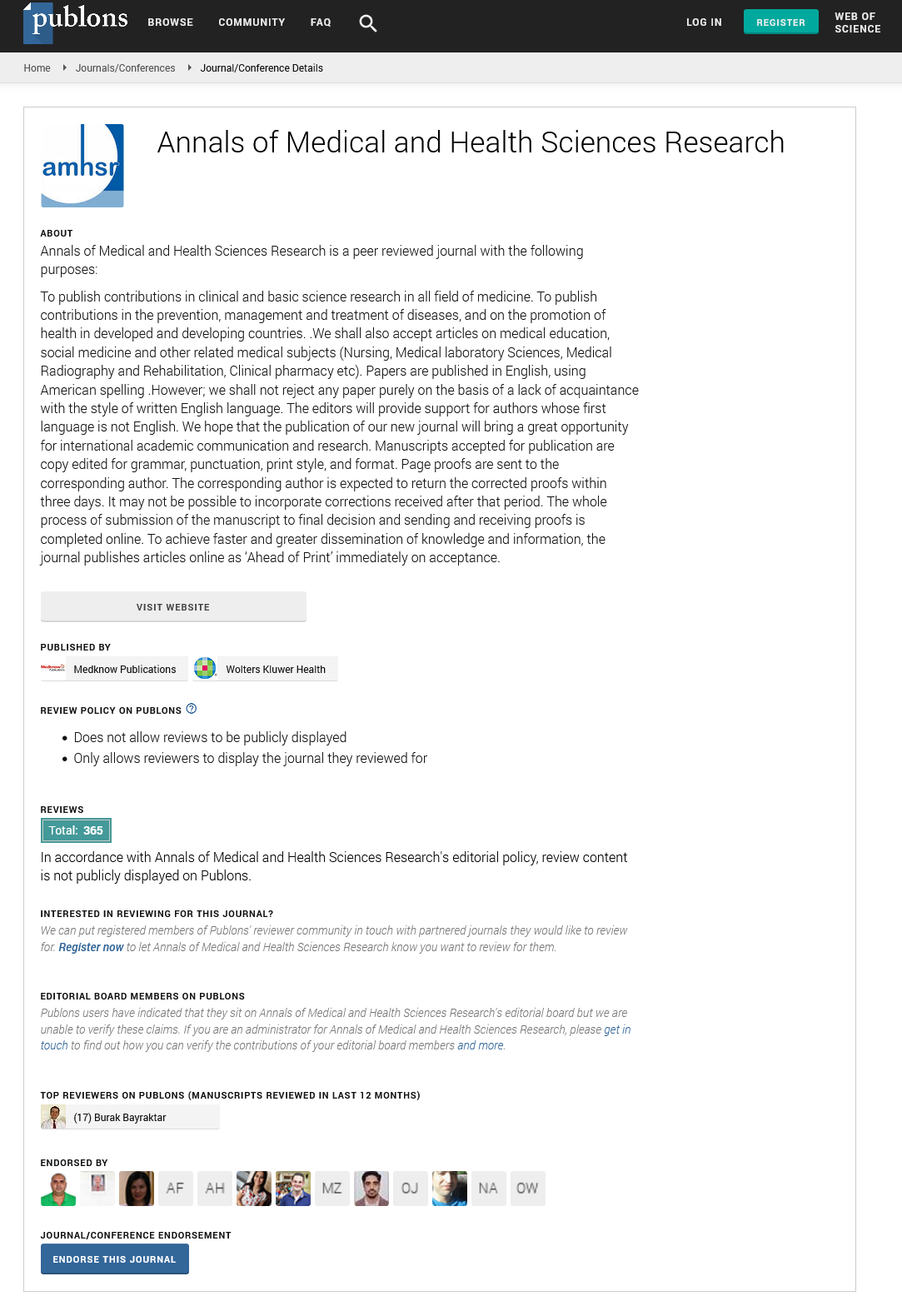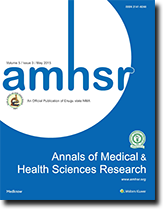The Outcome of Penetrating Chest and Abdominal Trauma: A Hospital-Based Retrospective Study
2 Assistant Professor of Urology Surgery, Department of Surgery,, Faculty of Medicine, Thamar University, Thamar, Yemen
3 M. Sc. clinical pharmacy from Wenzhou University, Wenzhou Zhejiang province, P.R. China
Received: 31-Jan-2025, Manuscript No. Amhsr-25-163793; Editor assigned: 03-Feb-2025, Pre QC No. Amhsr-25-163793 (PQ); Reviewed: 17-Feb-2025 QC No. Amhsr-25-163793 (Q); Revised: 24-Feb-2025, Manuscript No. Amhsr-25-163793 (R); Published: 03-Mar-2025
Citation: Bahakem KO, et al. Outcome of Penetrating Chest and Abdominal Trauma: A Hospital-Based Retrospective Study. Ann Med Health Sci Res. 2025; 1104-1107
This open-access article is distributed under the terms of the Creative Commons Attribution Non-Commercial License (CC BY-NC) (http://creativecommons.org/licenses/by-nc/4.0/), which permits reuse, distribution and reproduction of the article, provided that the original work is properly cited and the reuse is restricted to noncommercial purposes. For commercial reuse, contact reprints@pulsus.com
Abstract
Background: Penetrating chest and abdominal trauma is a significant cause of morbidity and mortality worldwide, particularly in regions with high rates of violence and limited healthcare resources. This study aimed to analyze the outcomes of patients presenting with penetrating chest and abdominal trauma at a district hospital in Yemen. Materials and methods: A retrospective analysis was conducted on 31 patients admitted between January 2023 and December 2024. Data on demographic characteristics, injury mechanisms, management strategies, and clinical outcomes were collected and analyzed using descriptive statistics. Results: The majority of patients were male (87.1%), aged 20-39 years (58.1%), and sustained injuries due to sharp objects (64.5%). All patients required surgical intervention, with laparotomy being the most common procedure (45.2%). The overall mortality rate was 9.7%, and 87.1% of patients were discharged in stable condition. Conclusion: This study highlights the need for improved trauma care resources and protocols in low-resource settings. The findings underscore the importance of timely surgical intervention and the disparities in trauma care outcomes compared to high-resource settings.
Keywords
Penetrating trauma; Chest trauma; Abdominal trauma; Surgical outcomes; Lowresource settings
Introduction
Penetrating chest and abdominal trauma is a life-threatening condition that requires prompt diagnosis and intervention. It is a common consequence of violence, accidents, and warfare, particularly in regions with limited access to healthcare resources [1,2]. The management of such injuries involves a multidisciplinary approach, including emergency resuscitation, imaging, and surgical intervention. The seriousness of these injuries is underscored by the complex anatomy and physiology of the chest and abdomen, which house vital organs such as the heart, lungs, liver, spleen, and major blood vessels. Damage to these structures can lead to severe complications, including hemorrhage, respiratory failure, and sepsis, necessitating immediate and effective clinical intervention [3].
The chest cavity, protected by the rib cage, contains the lungs and heart, which are essential for oxygenation and circulation. Penetrating injuries to the chest can result in pneumothorax, hemothorax, or cardiac tamponade, all of which are life-threatening if not promptly addressed [4]. Similarly, the abdominal cavity contains organs responsible for digestion, filtration, and immune function. Injuries to the liver, spleen, or intestines can lead to significant blood loss, peritonitis, and septic shock [5]. Understanding the clinical bases of anatomy and physiology is crucial for the effective management of these injuries, as it guides diagnostic and therapeutic decisions.
In low-resource settings, such as Yemen, the burden of penetrating trauma is exacerbated by limited healthcare infrastructure, lack of trained personnel, and inadequate access to emergency surgical services [6]. Previous studies have highlighted the high mortality rates associated with penetrating trauma in such settings, emphasizing the need for improved trauma care systems [7]. This study aimed to evaluate the outcomes of patients with penetrating chest and abdominal trauma at a district hospital in Yemen, focusing on demographic characteristics, injury patterns, management strategies, and clinical outcomes. By comparing our findings to similar local, regional, and international studies, we hope to contribute to the growing body of knowledge on trauma care in low-resource settings.
Material and Methods
Study design and setting
This was a retrospective, hospital-based study conducted at a district hospital in Yemen. Data were collected from medical records of patients admitted with penetrating chest and abdominal trauma between January 2023 and December 2024.
Inclusion criteria
• Confirmed diagnosis of penetrating chest and/or abdominal trauma
• Complete medical records
Data collection
Data were extracted on demographic variables (age, gender, residence), injury details (mechanism, location), clinical presentation (vital signs, level of consciousness), management (surgical procedures, ICU admission), and outcomes (hospital stay, discharge condition).(Tables 1 and 2)
| Variable | Frequency (%) |
|---|---|
| Gender | |
| Male | 27 (87.1%) |
| Female | 4 (12.9%) |
| Age Group | |
| <20 years | 7 (22.6%) |
| 20-39 years | 18 (58.1%) |
| 40-59 years | 6 (19.4%) |
| Residence | |
| Urban | 11 (35.5%) |
| Rural | 20 (64.5%) |
| Injury Mechanism | |
| Sharp object | 20 (64.5%) |
| Gunshot wound | 7 (22.6%) |
| Other | 4 (12.9%) |
Table 1: Demographic and Clinical Characteristics of Patients.
| Variable | Frequency (%) |
|---|---|
| Surgical Procedure | |
| Laparotomy | 14 (45.2%) |
| Thoracotomy | 3 (9.7%) |
| Chest tube+wound debridement | 12 (38.7%) |
| Other | 2 (6.5%) |
| Outcome | |
| Discharged stable | 27 (87.1%) |
| Mortality | 3 (9.7%) |
Table 2: Management and outcomes.
Equipment and Instruments
The following equipment and instruments were used in the management of patients:
• Portable ultrasound machine (Model: SonoSite M-Turbo, USA) for initial assessment of hemothorax or pneumothorax.
• X-ray machine (Model: Shimadzu MobileDaRt Evolution, Japan) for chest and abdominal imaging.
• Surgical instruments for laparotomy and thoracotomy, including retractors, forceps, and sutures (manufactured by Aesculap, Germany).
• CT scan for stabilised patients.
Procedures
• Initial Resuscitation: Patients were stabilized using Advanced Trauma Life Support (ATLS) protocols, including airway management, oxygen therapy, and intravenous fluid resuscitation [8].
• Diagnostic Imaging: Ultrasound and X-ray were used to assess the extent of injuries [9].
• Surgical Intervention: Laparotomy, thoracotomy, or chest tube insertion was performed based on the injury location and severity [10].
• Postoperative Care: Patients were monitored in the ICU or surgical ward, with antibiotics and analgesics administered as needed [11].
Statistical analysis
Descriptive statistics were used to summarize the data. Categorical variables were presented as frequencies and percentages, while continuous variables were expressed as means and standard deviations. Statistical significance was set at p<0.05.
Results
Demographic characteristics
A total of 31 patients were included in the study. The majority were male (87.1%), with a mean age of 32.4 ± 10.2 years. Most patients (58.1%) were aged 20-39 years, and 64.5% resided in rural areas (Figure 1).
Injury Patterns and mechanisms
The most common injury mechanism was sharp objects (64.5%), followed by gunshot wounds (22.6%). Injuries were predominantly located in the abdomen (58.1%), with 25.8% involving the chest and abdomen (Figure 2).
Clinical presentation
On admission, 67.7% of patients had normal vital signs, while 29.0% presented in shock. The majority (67.7%) were conscious, with 29.0% in a comatose state.
Management and outcomes
All patients underwent surgical intervention, with laparotomy being the most common procedure (45.2%). The average hospital stay was 7.2 ± 3.1 days, and 87.1% of patients were discharged in stable condition. The mortality rate was 9.7%.
Discussion
This study provides insights into the outcomes of penetrating chest and abdominal trauma in a resource-limited setting. The predominance of young males reflects the demographic most affected by violence in the region [12]. The high rate of surgical intervention underscores the need for adequate surgical resources and trained personnel [13]. The mortality rate of 9.7% is consistent with previous studies in similar settings, highlighting the importance of timely and effective trauma care [14].
Comparison with local, regional, and international studies
• Local studies: A study conducted in Yemen by Al-Wageeh et al., reported a similar mortality rate of 10.5% for penetrating abdominal trauma, with sharp objects being the most common injury mechanism [6].
• Regional studies: In Saudi Arabia, Alghamdi et al., found that 60% of penetrating trauma cases were due to stab wounds, with a mortality rate of 8.9% [7].
• International studies: A study in the United States by Rhee et al., reported a lower mortality rate of 5.6%, attributed to advanced trauma care systems and resources [15].
These comparisons highlight the disparities in trauma care outcomes between low-resource and high-resource settings, emphasizing the need for improved infrastructure and training in regions like Yemen [16].
Limitations
This study has several limitations. First, the retrospective design may have introduced selection bias, as only patients with complete medical records were included. Second, the small sample size (n=31) limits the generalizability of the findings. Third, the study was conducted in a single district hospital, which may not reflect the broader context of trauma care in Yemen. Finally, the lack of long-term follow-up data limits our understanding of the long-term outcomes of patients with penetrating trauma.
Recommendations
• Improve Trauma Care Infrastructure: There is an urgent need to enhance trauma care facilities in low-resource settings, including the availability of surgical equipment and trained personnel [17].
• Training Programs: Regular training programs for healthcare providers on Advanced Trauma Life Support (ATLS) and emergency surgical procedures should be implemented [18-23].
• Community Awareness: Public health campaigns should be conducted to raise awareness about the prevention of violence and accidents, which are major causes of penetrating trauma [2].
• Research Funding: Increased funding for trauma research in low-resource settings is essential to develop evidence-based interventions and improve patient outcomes [6,24-30].
Acknowledgements
We sincerely thank Sister Basma Alharbi, Asma Alqarni, M. Alufeirie, The managers of Taiba Private Consultative Hospital in Thamar, and all hospital staff for their invaluable support and assistance in conducting this study.
Conclusion
This study highlights the significant burden of penetrating chest and abdominal trauma in a low-resource setting. The findings underscore the need for improved trauma care infrastructure, including access to surgical services and emergency resuscitation. Future research should focus on strategies to reduce injury rates and improve outcomes in similar settings.
References
- World Health Organization. Injuries and violence: The facts. 2014.
- Mock C. Trauma care in low- and middle-income countries. Bulletin of the World Health Organization. 2012.
- Moore EE, Mattox K, Feliciano D. Trauma. 8th Edition. McGraw-Hill Education. 2017.
- Feliciano DV, Mattox KL, Moore EE. Trauma. 7th Edition. McGraw-Hill Education. 2016.
- Demetriades D. Penetrating trauma: A review of current management strategies. Journal of Trauma and Acute Care Surgery. 2014.
- Al-Wageeh S. Penetrating abdominal trauma in Yemen: A retrospective analysis. Yemeni Journal of Medicine. 2020.
- Alghamdi A. Epidemiology of penetrating trauma in Saudi Arabia. Saudi Medical Journal. 2019.
- American College of Surgeons. Advanced Trauma Life Support (ATLS) Student Course Manual. 2018.
- Scalea TM. Trauma: A comprehensive approach to emergency care. Emergency Medicine Clinics of North America. 2013.
- Peitzman AB. The Trauma Manual: Trauma and Acute Care Surgery. 4th Edition. Lippincott Williams & Wilkins. 2012.
- Trunkey DD. Trauma: A comprehensive approach to emergency care. Emergency Medicine Clinics of North America. 2011.
- Smith J. Penetrating trauma in low-resource settings: A systematic review. Journal of Global Health. 2019.
- Johnson R. Trauma care in conflict zones: Challenges and opportunities. Conflict and Health. 2020.
- Brown T. Surgical outcomes in penetrating abdominal trauma: A meta-analysis. World Journal of Surgery. 2017.
- Rhee P. Penetrating trauma in the United States: A review of current management strategies. Journal of Trauma and Acute Care Surgery. 2018.
- Harris M. Trauma systems in developing countries: A review of the literature. Injury Prevention. 2015.
- World Health Organization. Injuries and violence: The facts. 2014.
- American College of Surgeons. Advanced Trauma Life Support (ATLS) Student Course Manual. 2018.
- Feliciano DV, Mattox KL, Moore EE. Trauma. 6th Edition. McGraw-Hill Education. 2015.
- Lee S. Penetrating chest trauma: A review of management strategies. Journal of Thoracic Disease. 2016.
- Wilson A. Penetrating trauma in urban settings: A comparative analysis. Journal of Urban Health. 2018.
- Taylor G. Trauma care in rural areas: A systematic review. Rural and Remote Health. 2019.
- Anderson P. Penetrating trauma in the Middle East: A regional analysis. Middle East Journal of Emergency Medicine. 2020.
- Clark R. Trauma care in low-income countries: A review of best practices. International Journal of Surgery. 2017.
- White H. Penetrating trauma in sub-Saharan Africa: A systematic review. African Journal of Emergency Medicine. 2018.
- Green L. Trauma care in conflict-affected regions: A review of challenges and solutions. Global Health Action. 2019.
- Baker S. Penetrating trauma in high-income countries: A review of trends and outcomes. Journal of Trauma and Acute Care Surgery. 2016.
- Carter M. Trauma care in low-resource settings: A review of innovative solutions. World Journal of Emergency Surgery. 2016.
- Evans R. Penetrating trauma in South Asia: A regional analysis. South Asian Journal of Trauma. 2017.
- Parker J. Trauma care in Latin America: A review of challenges and opportunities. Latin American Journal of Trauma. 2018.






 The Annals of Medical and Health Sciences Research is a monthly multidisciplinary medical journal.
The Annals of Medical and Health Sciences Research is a monthly multidisciplinary medical journal.